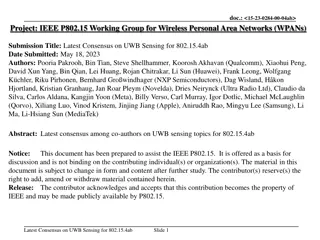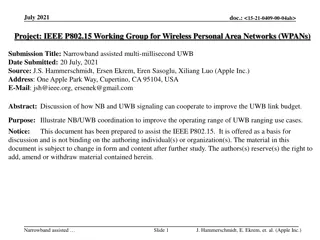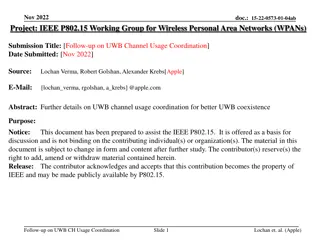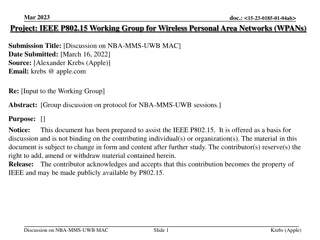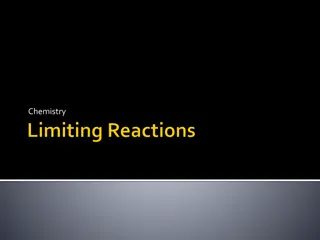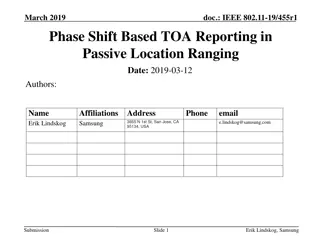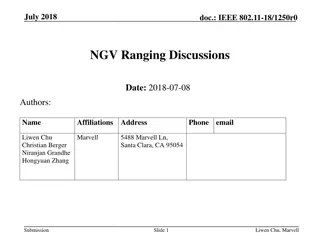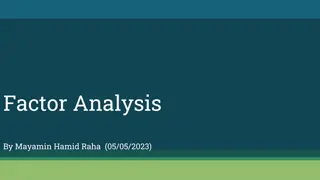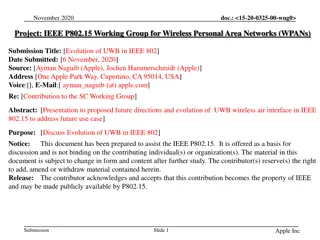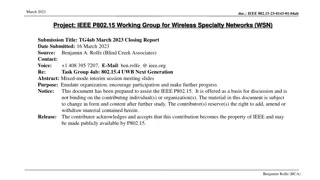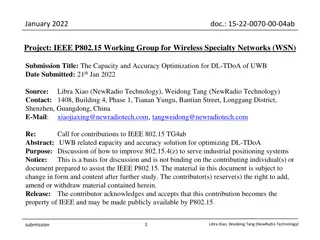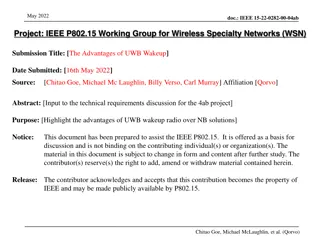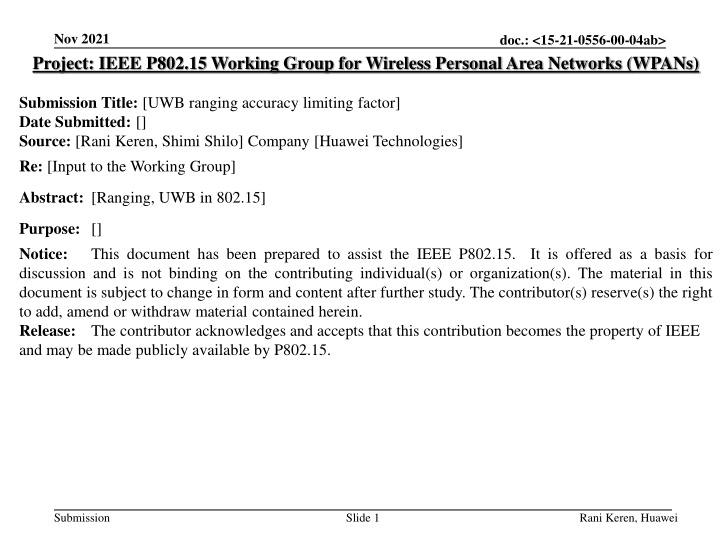
Improving Ranging Accuracy in UWB Systems
"Explore the accuracy limiting factors in UWB ranging for IEEE P802.15 WPANs. Dive into TOA estimation and channel impulse response to enhance precision and reliability. Discover solutions for interference mitigation, coexistence, and improved link budget."
Uploaded on | 0 Views
Download Presentation

Please find below an Image/Link to download the presentation.
The content on the website is provided AS IS for your information and personal use only. It may not be sold, licensed, or shared on other websites without obtaining consent from the author. If you encounter any issues during the download, it is possible that the publisher has removed the file from their server.
You are allowed to download the files provided on this website for personal or commercial use, subject to the condition that they are used lawfully. All files are the property of their respective owners.
The content on the website is provided AS IS for your information and personal use only. It may not be sold, licensed, or shared on other websites without obtaining consent from the author.
E N D
Presentation Transcript
Nov 2021 Project: IEEE P802.15 Working Group for Wireless Personal Area Networks (WPANs) doc.: <15-21-0556-00-04ab> Submission Title: [UWB ranging accuracy limiting factor] Date Submitted: [] Source: [Rani Keren, Shimi Shilo] Company [Huawei Technologies] Re: [Input to the Working Group] Abstract: [Ranging, UWB in 802.15] Purpose: [] Notice: discussion and is not binding on the contributing individual(s) or organization(s). The material in this document is subject to change in form and content after further study. The contributor(s) reserve(s) the right to add, amend or withdraw material contained herein. Release: The contributor acknowledges and accepts that this contribution becomes the property of IEEE and may be made publicly available by P802.15. This document has been prepared to assist the IEEE P802.15. It is offered as a basis for Submission Slide 1 Rani Keren, Huawei
Nov 2021 doc.: <15-21-0556-00-04ab> PAR Objective Proposed Solution (how addressed) Safeguards so that the high throughput data use cases will not cause significant disruption to low duty-cycle ranging use cases Interference mitigation techniques to support higher density and higher traffic use cases Other coexistence improvement Backward compatibility with enhanced ranging capable devices (ERDEVs) Improved link budget and/or reduced air-time Additional channels and operating frequencies Improvements to accuracy / precision / reliability and interoperability for high-integrity ranging Reduced complexity and power consumption Analyze ranging accuracy limiting factor of solutions based on current standard (802.15.4-2020) Hybrid operation with narrowband signaling to assist UWB Enhanced native discovery and connection setup mechanisms Sensing capabilities to support presence detection and environment mapping Low-power low-latency streaming Higher data-rate streaming allowing at least 50 Mbit/s of throughput Support for peer-to-peer, peer-to-multi-peer, and station-to- infrastructure protocols Infrastructure synchronization mechanisms Submission Slide 2 Rani Keren, Huawei
Nov 2021 doc.: <15-21-0556-00-04ab> Introduction An initial step towards improving ranging accuracy in the next generation standard would be identifying the accuracy limiting factor of solutions based on the current standard (802.15.4-2020). The ranging accuracy is determined by the frame TOA (Time-of-Arrival) estimation, which is typically based on the receiver detection of channel s earliest path within the estimated CIR (Channel Impulse Response). Submission Slide 3 Rani Keren, Huawei
Nov 2021 doc.: <15-21-0556-00-04ab> Earliest Path Detection ( ) t ( ) t 1 N ( ) ptx prx = i a t i i 0 We define a UWB system that includes: A transmit shaping filter with impulse response A multipath channel with paths, characterized by a set of complex amplitudes and delays where path index range is A receive filter with impulse response We denote the impulse response of the cascaded transmit and receive filters by and refer to it as the receive pulse shape . The expected receiver estimated CIR includes a sum of scaled and delayed copies of the receive pulse shape and additive noise : ( ) t ptx N i i ia 0 ... 1 N ( ) t prx ( ) t ( ) t ( ) t = p p p tx rx ( ) t n 1 N ( ) t ( ) ( ) t = i = + h a p t n i i 0 Submission Slide 4 Rani Keren, Huawei
Nov 2021 doc.: <15-21-0556-00-04ab> Earliest Path Detection - Cont. TOA (Time of Arrival) requires detecting the time-position within the CIR estimation of the receive pulse that corresponds to the channel earliest path. As an example, we analyze a NLOS scenario with 4 sparse paths and no noise. In case the receive pulse shape has a single peak, finding the earliest path can be carried out simply by finding the CIR s earliest peak. Submission Slide 5 Rani Keren, Huawei
Nov 2021 doc.: <15-21-0556-00-04ab> Earliest Path Detection - Cont. A practical receive pulse shape generated by a SRRC (Square Root Raised Cosine) transmit filter with Beta=0.45 and its corresponding receive matched filter includes a precursor peak that is 17dB below the main peak In order to avoid false detections of precursor peaks, it is required to set a detection threshold to around 17dB below the global maximum peak. However, this results in misdetection of the earliest path that is 20dB below the strongest path in our example. Maximum Peak to Early Peak Ratio (MPEP) Detection Threshold Submission Slide 6 Rani Keren, Huawei
Nov 2021 doc.: <15-21-0556-00-04ab> Earliest Path Detection - Cont. The current standard recommends using a no-precursor transmit filter for increased ranging reliability. A receive pulse shape that corresponds to a no-precursor TX filter (8th order Butterworth) and a SRRC RX filter has a reduced precursor peak that is 27dB below the main peak. This allows us to reduce the detection threshold to around 27dB below the global peak, which enables reliable detection of the earliest path that is 20dB below the strongest path. Maximum Peak to Early Peak Ratio (MPEP) Detection Threshold Submission Slide 7 Rani Keren, Huawei
Nov 2021 doc.: <15-21-0556-00-04ab> Earliest Path Detection - Cont. In case of a small time-gap between first path and second path, their corresponding pulses are merged to a single pulse. This results in a high bias of earliest path detection. In our example, when gap is lower than 3nSec, the stronger pulse masks the earliest weak pulse and dominates the estimation. When gap is greater than 5nSec, the earliest path is accurately identified. Submission Slide 8 Rani Keren, Huawei
Nov 2021 doc.: <15-21-0556-00-04ab> Jump Backwards, Search Forward Back-Search Time Window (BTW) Maximum Peak to Early Peak Ratio (MPEP) Peak to Average Power Ratio (PAPR) A typical receiver TOA implementation: JBSF (Jump Backwards, Search Forward) From the global maximum, jump backwards by a preconfigured duration BTW (Back-search Time Window) and search forward across the CIR estimation for the earliest local peak above an adaptive detection threshold. The detection threshold is set as the higher of the following two: MPEP (Maximum Peak to Early Peak ratio) below global maximum (avoid precursor peak detection) PAPR (Peak to Average Power Ratio) above noise floor (avoid noise peaks detection) Interpolation method can be used for fine tuning the peak location beyond samples interval precision. JBSF advantages: Low complexity, low sensitivity to noise, low sensitivity to the total number of channel paths. Submission Slide 9 Rani Keren, Huawei
Nov 2021 doc.: <15-21-0556-00-04ab> JBSF TOA: Simulation Results Channel 802.15.4a UWB channel model Transmitter Receiver AWGN Frame Detection/ CIR estimation Earliest Path Detection SHR generation TX shaping filter Channel filter RX filter Compare Transmission of SHR with 8th order Butterworth pulse shaping 802.15.4a UWB channel model (Residential NLOS mode), 100 channel realizations Reception with SRRC filter, frame detection and CIR estimation, JBSF earliest path detection JBSF configuration: BTW = 128nSec, MPEP=25dB, PAPR=8dB, Quadrature interpolation, x2 oversampling (1Gsps) Submission Slide 10 Rani Keren, Huawei
Nov 2021 doc.: <15-21-0556-00-04ab> TOA accuracy CDF is plotted for first path, first 2 paths, first 3 paths and all paths First path gives very accurate TOA for all channel realizations: absolute error smaller than 0.05nSec. For first 2 paths or more, 50% of the channel realizations introduce a high TOA estimation bias of up to 3nSec. The accuracy limiting factor is the estimation bias due a dense group of early paths which prevents identifying the earliest one among them (mainly due to the 2 paths immediately following the earliest) See example below where the first two paths merge into a single peak pulse with a biased location. Submission Slide 11 Rani Keren, Huawei
Nov 2021 doc.: <15-21-0556-00-04ab> Summary For a typical UWB transceiver implementing low complexity TOA algorithm, the ranging accuracy is limited by channel scenarios that include a dense group of paths near the earliest path. The receive pulses corresponding to these paths in the CIR are being merged, resulting in high bias of the earliest path estimation. It is suggested that the group focuses on the above issue when proposing solutions for ranging accuracy improvement. Possible ways forward: Higher complexity receiver algorithms that rather than directly detect the earliest path, search for a combination of amplitudes and delays that best fits the CIR estimation. Knowledge of the receive pulse shape is required. New transmission scheme. Submission Slide 12 Rani Keren, Huawei


